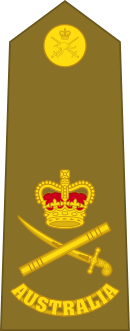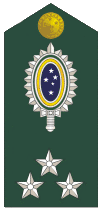Three-star rank
An officer of three-star rank is a senior commander in many of the armed services holding a rank described by the NATO code of OF-8. The term is also used by some armed forces which are not NATO members. Typically, three-star officers hold the rank of vice admiral, lieutenant general, or in the case of those air forces with a separate rank structure, air marshal.

Australia
In the Australian Defence Force the following ranks of commissioned officers are awarded three-star ranks:
- Vice admiral (Royal Australian Navy three-star rank)
- Lieutenant general (Australian Army three-star rank)
- Air marshal (Royal Australian Air Force three-star rank)
Official rank insignia for Australian 'three-star' officers do not use stars in the same fashion as the United States. The RAN does incorporate stars into the hardboard rank insignia for flag-rank officers but this is in conjunction with other devices. Unofficial star rank insignia are sometimes worn when serving with or visiting other military organisations in order to facilitate equivalent rank recognition.
The Chiefs of all three services within the Australian Defence Force hold three-star rank as well as four joint positions: Vice Chief of Defence Force (VCDF), Chief of Joint Operations (CJOPS), Chief Capability Development Group (CCDG), and Chief of Defence Intelligence.
Bangladesh
- Inspector general of Police (Bangladesh Police three-star rank)
- Lieutenant general (Bangladesh Army three-star rank)
- Vice admiral (Bangladesh Navy three-star rank)
- Air marshal (Bangladesh Air Force three-star rank)
Brazil
- Vice Almirante (Brazilian Navy three-star rank)
- General de Divisão (Brazilian Army three-star rank)
- Major Brigadeiro (Brazilian Air Force three-star rank)
The three-star rank in Brazil is the second rank in a general career. The officers in this position are normally divisional commanders.
Cambodia
- Odom Senei Ek (Lieutenant-General) - Royal Cambodian Army
- Odom Neavi Ek (Vice-Admiral) - Royal Cambodian Navy
- Odom Senei Ek (Lieutenant-General) - Royal Cambodian Air Force
 Odom Senei Ek
Odom Senei Ek
Army rank insignia Odom Neavi Ek
Odom Neavi Ek
Navy rank insignia Odom Senei Ek
Odom Senei Ek
Air Force rank insignia
Canada
- Vice admiral / vice-amiral (Royal Canadian Navy three-star-equivalent rank)
- Lieutenant-general / lieutenant-général (Canadian Army and Royal Canadian Air Force three-star-equivalent rank)
Three maple leaves appear with St. Edward's crown and crossed sabre and baton. Prince Charles holds the rank of vice-admiral in an honorary capacity. Before unification, the rank of air marshal was the three-star equivalent for the RCAF.
Germany
The equivalent modern German three-star ranks (OF-8) of the Bundeswehr are as follows:
Not to be confused with the Generalleutnant and Vizeadmiral (two-star ranks; OF-7) of the Wehrmacht until 1945 or the National People's Army (East Germany) until 1990.
India
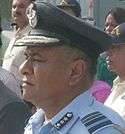
- Air Marshal (Indian Air Force three-star rank)[1]
- Lieutenant general (Indian Army three-star rank)[1]
- Vice Admiral (Indian Navy three-star rank)[1]
- Director general (Indian Police Service three-star rank)
Indonesia
- Letnan Jendral (Lieutenant-General) - Indonesian Army and Indonesian Marine Corps three-star rank
- Laksamana Madya (Vice-Admiral) - Indonesian Navy and Indonesian Maritime Security Agency three-star rank
- Marsekal Madya (Air-Marshal) - Indonesian Air Force three-star rank
- Komisaris Jenderal (Commissioner-General of the Police) - Indonesian National Police three-star rank
 Letnan Jendral Army rank insignia
Letnan Jendral Army rank insignia Laksamana Madya Navy rank insignia
Laksamana Madya Navy rank insignia Marsekal Madya Air Force rank insignia
Marsekal Madya Air Force rank insignia Laksamana Madya Maritime Security Agency rank insignia
Laksamana Madya Maritime Security Agency rank insignia Komisaris Jenderal Police rank insignia
Komisaris Jenderal Police rank insignia
Pakistan
- Inspector-General of the Police (Police Service of Pakistan)
- Lieutenant-General (Pakistan Army three-star rank)
- Air-Marshal (Pakistan Air Force three-star rank)
- Vice Admiral (Pakistan Navy three-star rank)
Philippines
- Lieutenant general (Philippine Army three-star rank)
- Lieutenant general (Philippine Air Force three-star rank)
- Vice admiral (Philippine Coast Guard three-star rank)
- Vice admiral (Philippine Navy three-star rank)
- Deputy Commissioner (Bureau of Immigration three-star rank)
- Police Deputy Director General (Philippine National Police three-star rank)
United Kingdom
- Vice admiral (Royal Navy three-star rank)
- Lieutenant general (British Army and Royal Marines three-star rank)[2]
- Air marshal (Royal Air Force three-star rank)[3]
 Royal Navy shoulder board (since 2001)
Royal Navy shoulder board (since 2001)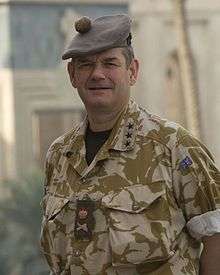 Lieutenant-General John Cooper wearing both three-star insignia and lieutenant general insignia
Lieutenant-General John Cooper wearing both three-star insignia and lieutenant general insignia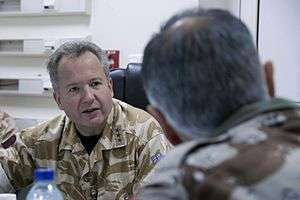 Air Marshal C N Harper wearing three-star insignia
Air Marshal C N Harper wearing three-star insignia
United States
.jpg)
- Vice admiral (United States Navy, Coast Guard, Public Health Service Commissioned Corps and National Oceanic and Atmospheric Administration Commissioned Corps, three-star rank)
- Lieutenant general (United States Army, Marine Corps and Air Force three-star rank)
A vice admiral typically commands a numbered fleet which is responsible for all naval ships within its area of responsibility. An Army or Marine Corps lieutenant general typically commands a corps-sized unit (20,000 to 45,000 soldiers), while an Air Force lieutenant general commands a large Numbered Air Force consisting of several wings. Additionally, lieutenant generals and vice admirals of all services serve as high-level staff officers at various major command headquarters and the Pentagon, often as the heads of their departments.
Russia and the USSR
In the Russian and Soviet armies, the three-star rank is colonel-general (Russian: генерал-полковник) and full admiral (Russian: адмирал). These military ranks, along with other general and admiralty ranks, appeared in 1940. Most Warsaw Pact and Soviet-aligned countries adopted this rank. The rank is often held by commanders of the ground forces, chiefs of military academies and commanders of military districts. Colonel general is considered a stepping stone to the rank of general of the army, itself essential to achieving the high rank of marshal of the Russian Federation. This title also applies to three star officers of the air force, MVD, police and militia, internal troops, FSB/KGB, border guards and some others. In the navy, the three star rank is admiral (Russian: адмирал).
Ukraine
Armed Forces of Ukraine
From June 16, 1920, in Ukraine, a colonel general becomes a three-star general (before that rank was two-star) [4]. Since 1921, the UPR ceased to exist due to the occupation of Red Army.
In 1991, Ukraine regained its independence. In the Armed Forces of Ukraine (as in other countries formed on the ruins of the USSR), the ranks and insignia were kept to the Soviet standard. Three stars on the shoulder straps have a colonel general (Ukrainian: Генерал-полковник) and an admiral (Ukrainian: Адмірал).
On July 5, 2016, he was approved by the President of Ukraine “The Unicorn Project and the Distinction Marks of the Armed Forces of Ukraine”. The draft addresses, among other things, the insignia of military personnel. It was supposed to reform the list of military ranks, among others the rank of brigadier general and commodore were to appear, and the rank of lieutenant general and vice admiral were three-star ranks.[5]
On November 20, 2017, the decree of the Ministry of Defense of Ukraine № 606 is issued, which specifies the rules for wearing and using unilateral servicemen. Colonels and admirals continue to wear three stars on the shoulder straps, but the stars instead of five rays become four rays[6][7].
National Police of Ukraine
Following the restoration of independence by Ukraine in 1991, law enforcement agencies (militsiya) used special ranks on the Soviet model that corresponded to military rank. In 2015, law enforcement was reformed, resulting in national police appearing. Instead of the three-star rank of "colonel-general of the militsiya", the title of "first division general" appears.[8]
 |
 |
 |
 |
 |
 |
 |
 |
 |
 |
| Colonel general (1920-1921) |
Colonel general (1991-2009) |
Colonel general (2009-2016) |
Admiral (u. 2016) |
Lieutenant general (project, 2016) |
Vice admiral (project, 2016) |
Colonel general (s. 2016) |
Admiral (s. 2016) |
Colonel general militsiy (u. 2016) |
First division general (s. 2016) |
See also
- Corps general
- Ranks and insignia of NATO
- Four-star rank
- Two-star rank
Notes
References
- Selections from Regional Press. Institute of Regional Studies. October 2007. p. 75.
- Officers' rank insignia Archived 2009-12-14 at the Wayback Machine, British Army Website. Retrieved 2008-10-25.
- RAF Glossary Archived 2008-04-13 at the Wayback Machine
- Чмир М. Відзнаки військових звань українських збройних формувань 1917—1921 рр.
- Президент затвердив нові предмети однострою та знаки розрізнення Збройних Сил України
- Текст наказу Міністерства оборони України №606 від 20.11.2017 р.
- Текст наказу Міністерства оборони України №606 від 20.11.2017 р. на сайті Ліга Закон
- Текст Закону України «Про Національну поліцію» на сайті Голос України

